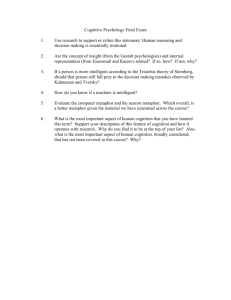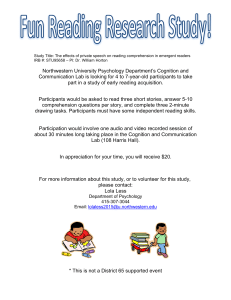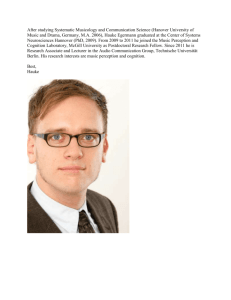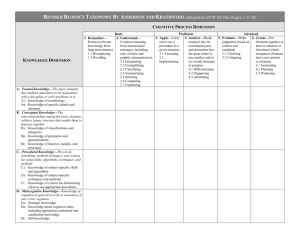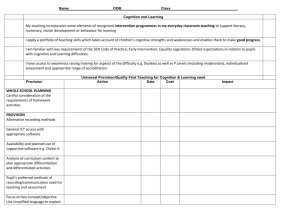Matteson-proposal - UNC School of Information and Library
advertisement
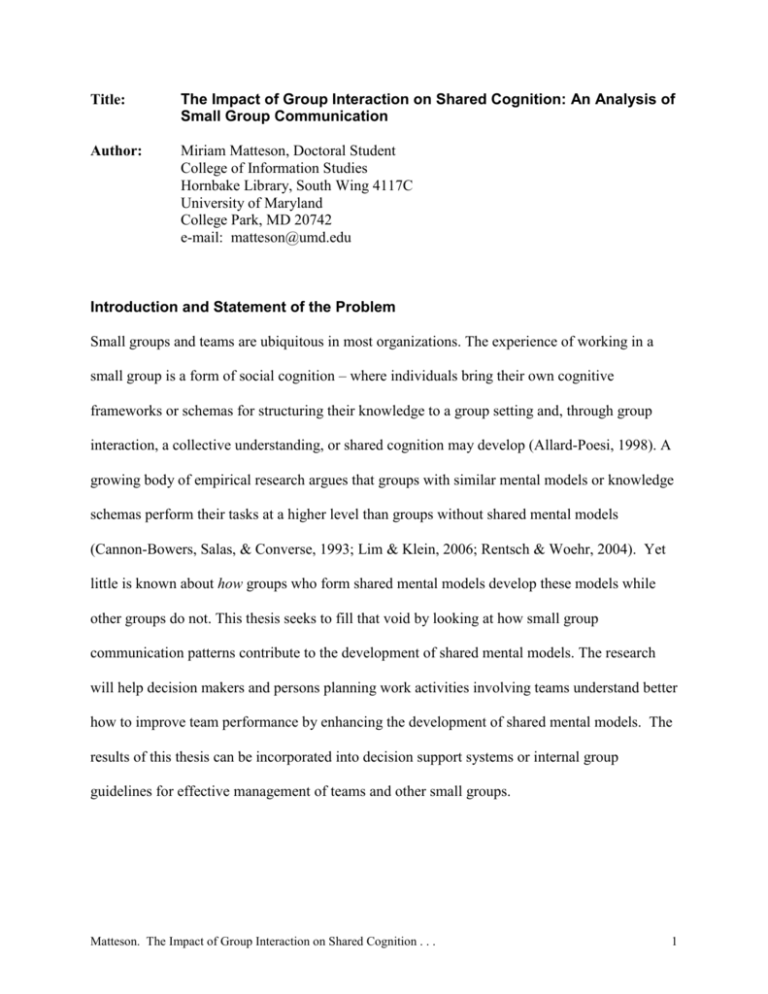
Title: The Impact of Group Interaction on Shared Cognition: An Analysis of Small Group Communication Author: Miriam Matteson, Doctoral Student College of Information Studies Hornbake Library, South Wing 4117C University of Maryland College Park, MD 20742 e-mail: matteson@umd.edu Introduction and Statement of the Problem Small groups and teams are ubiquitous in most organizations. The experience of working in a small group is a form of social cognition – where individuals bring their own cognitive frameworks or schemas for structuring their knowledge to a group setting and, through group interaction, a collective understanding, or shared cognition may develop (Allard-Poesi, 1998). A growing body of empirical research argues that groups with similar mental models or knowledge schemas perform their tasks at a higher level than groups without shared mental models (Cannon-Bowers, Salas, & Converse, 1993; Lim & Klein, 2006; Rentsch & Woehr, 2004). Yet little is known about how groups who form shared mental models develop these models while other groups do not. This thesis seeks to fill that void by looking at how small group communication patterns contribute to the development of shared mental models. The research will help decision makers and persons planning work activities involving teams understand better how to improve team performance by enhancing the development of shared mental models. The results of this thesis can be incorporated into decision support systems or internal group guidelines for effective management of teams and other small groups. Matteson. The Impact of Group Interaction on Shared Cognition . . . 1 Research Question The overarching research question is: How does group communication contribute to the development of shared mental model(s)? To answer this question it is necessary to understand: (1) the nature of communication within the group including the sequencing of messages, the themes discussed, the communication roles individuals play, the function of the communication messages (task oriented or socioemotional-oriented), the channels used to communicate, the degree of formality in the message, and the communication norms that emerge; 2) the mental model(s) as they develop over time; and (3) the relationship between the communication and the mental models. Method The research will be structured as a case study, following the traditions of naturalistic inquiry. Because the research questions seek to explore the meaning, processes, and context of a phenomenon through the voice of the participants, the qualitative paradigm is the appropriate approach (Maxwell, 1996). A particular strength of qualitative methods is the depth and complexity of the data used for analysis. This study collects data from observation, interview, and textual artifacts. Data collected through these qualitative methods emphasize the participant’s voice over the researcher’s, reflecting the world as constructed by the participant (Frey, 1994). In this study in particular, which seeks to capture the mental models of the participants, it is important to employ research methods that privilege the voice of the participants. Participants The research will study a small group within an organization over an extended period of time. A specific group has not yet been identified, but the theoretical assumptions guiding this research Matteson. The Impact of Group Interaction on Shared Cognition . . . 2 provide certain constraints on appropriate group types. The group should be a work group, as opposed to a social or support group. It should be a small group, preferably five to ten members, because of the data intensive nature of qualitative research. The group should be beginning a task, and the task should be non-routine and relatively complex, i.e., something that would require multiple group communication events including meetings and e-mail messages, and it should reach an end-state. Ideally the group will be situated in an archive or library within the greater Washington, D.C. / Baltimore area. Data Collection and Analysis Two types of data will be collected: data that reflects interaction and communication, and mental model-related data derived primarily from several interviews over the course of the study with each group member. Interaction/Communication Data. The first type of data to be collected will be data on the communication events and interactions that occur among the group members throughout the duration of the study. These data will include: Audio transcripts of group meetings Diary entries from group members recording communication events that occur outside the time the researcher is present to capture them Written communication in the form of documents, memos, or e-mail messages that the group use to communicate Researcher field notes from observing the group’s meetings These interaction data will be coded to characterize different aspects of communication within the group. First, each communication event will be coded by speaker, recipient (group or individual), channels, length of message, sequencing (i.e., turn-taking, communication flow), and decision procedures. Through these codes basic patterns of communication begin to emerge, and the coded data will be used to answer questions about communication norms and rules that develop in the group. Once the patterns have been identified as rules, the data can be re- Matteson. The Impact of Group Interaction on Shared Cognition . . . 3 evaluated to identify how the group ensures following the rules or imposes sanctions, if any, for not observing rules. The interaction data will also be coded by Bales (1950) Interaction Process Analysis (IPA) coding. IPA is a widely used functional scheme for group interactions. It focuses on micro-level interaction at the level of an utterance or message and uses a set of twelve mutually exclusive codes along two dimensions, task-oriented and socioemotional-oriented (Keyton, 2003). Coding with IPA sets the stage for several important sub-tasks: 1) segmenting the communication into task-related and socio-emotionally related communication; 2) identifying positive/negative communication; 3) characterizing functions more specifically into areas such as clarifying, relieving tension, showing solidarity, etc. With this coding it will be possible to develop a holistic picture of the nature of the communication within the small group. The functional aspects of the communication can be traced over time and related to specific changes in the shared mental models. A matrix of communication type by channel will show which channels are used for what function. The IPA categories are unsatisfactory for conveying the content of the messages, so, for that purpose, using a constant comparison approach, the interactions will be coded for content themes, i.e., topics discussed by two or more participants over a period of time. This method is suggested by Wheelan et al. (1994). The constant comparison approach will allow for flexibility in noting areas of interest, observing the influence of the nature of the task, and for conflicts and agreements on content. The data included in the field notes will be added to the thick, rich portrayal of the case; the reflective comments will be matched with the data from other sources to guide the development of categories and themes in the analysis. Matteson. The Impact of Group Interaction on Shared Cognition . . . 4 Mental Models. The second type of data is information that reflects individual group members’ mental models of the task at three different points during the study, roughly corresponding to the beginning, middle, and end of the project, but the timing of the interviews may also reflect significant changes in the shared mental model(s). These data will be collected through interviews with each group member. An initial interview with each member will be conducted at the outset of the study. This interview will be used to elicit the content and structure of the person’s mental model about the task at the beginning of the work. The interview questions will also draw out information about the internal relationships among group members. The protocol will be a series of open ended questions. This data will be used to create a representation of the individual’s understanding regarding the task. The data will also be used to construct a sociogram, a graphic representation of links among people, to understand the nature of the relationships among group members. Second and third interviews will be conducted midway and at the end of the task or after critical points in the task, using the same questions at each interview to capture individual mental models at different points in time. The data from the interviews will be transcribed and coded using a constant comparative approach in which the codes emerge from the data. The codes will be based broadly on data related to the task and data related to team interaction. (These will be separate questions in the interview schedule, facilitating the initial coding.) First, the data on task will be coded. Next, concept maps will be created for each participant, mapping their coded responses about the task in the form of the concepts elicited and the relationships identified between the concepts (Jackson & Trochim, 2002). The presence and strength of similarity will be assessed based on Matteson. The Impact of Group Interaction on Shared Cognition . . . 5 the number of concepts in common across the maps and the similarity of the relationships identified. Second, the data on team interaction will be analyzed in a similar manner. A type of sociogram, a graphic representation of links among people, will be constructed to model the internal perceptions group members report about the roles and responsibilities in the group; the information sources and communication channels used, and the interaction patterns noted. Similarity assessments will be made based on the coded data. This qualitative analysis allows for degrees of similarity to be detected, indicating shades of overlap among the team interaction mental models. Relating Communication to Shared Mental Models. The final stage of the data analysis relates the development of shared mental models with the different aspects of communication. This integration combines the interaction data and the interview data from the earlier stages. First, the group mental models will be examined over time to identify changes and consistencies. Then, the interaction data collected up to the time of the measurement of the mental model will be reviewed to identify elements that relate to the changes or to the consistencies to understand how they impacted the change or consistency in mental models. Tracing the interaction data for a particular change forms an audit trail to show how communication influences the developments in this particular group’s mental models. For example, consider the hypothetical Team ABC. This team of five members was assembled to work on a particular task. After several formal meetings and informal e-mail exchanges, group roles began to solidify: team member 1 emerged as a leader who generated many of the ideas, while other team members fell into other task and relational roles, such as Critic, Encourager, Recorder, and Follower. Communication norms relevant to a shared team Matteson. The Impact of Group Interaction on Shared Cognition . . . 6 model developed regarding how speaking turns were taken during meetings, how procedural decisions were reached, and whether conversation themes could be revisited after discussion or not. Based on IPA coding, most of the conversation tended to be task-oriented, focusing on defining the task [content theme], although many of the messages uttered by the Encourager were socioemotionally oriented. The conversations could be further disaggregated into the twelve IPA categories. By the midpoint of the project, the leader believed an understanding of the task had been agreed upon. Then one day, the Follower, who was usually reluctant to speak up at meetings, suggested another way to complete the task to the Encourager in the elevator. The Encourager liked the idea, expressed that to the Follower and shared it with the Recorder, who also responded favorably. As the Recorder, he sent out the idea as an agenda item for the next meeting. At their next meeting, the Encourager presented the alternative and the Follower chimed in to support the idea. During the discussion, the Critic asked questions continually, ignoring the group norms established regarding conversational sequencing, and repeatedly questioned the efficacy of the alternative. After a thorough discussion of the alternative, guided by the Critic’s questions, the leader expressed her support of the alternative, too, and called for a vote, conforming to the procedural norms established. The alternative passed unanimously and was recorded in the minutes. This scenario draws on the transcript of the group’s meeting, diary entries about the informal events, and formal documentation (the agenda), all of which were coded in various ways so that they could be retrieved and used to re-create the activities leading up to the change in the group’s understanding of the task. In this scenario, measures of the mental model of the group’s task would have shown a change from time one to time two. From an analysis of the Matteson. The Impact of Group Interaction on Shared Cognition . . . 7 communication data between those two points in time, events such as the informal elevator conversation, the role of the Encourager supporting the change, and the Socratic nature of the discussion lead by the Critic at the meeting are linked through an audit trail to show how the group’s mental model about the task changed over time. It is possible then to characterize the communication by the ratio of socioemotional to task-oriented, the types of channels, the roles, adherence to norms, degree of formality, and so on. From the analyses of the audit trails which emerge from the research data, such as the one described above, larger communication patterns can be characterized and generalized into a set of propositions about the influence of small group communication patterns on group shared mental models. Significance Given the empirical support for shared mental models as an indicator of team performance, research is needed that examines how groups reach shared mental models, particularly field research that focuses on natural groups. By studying the communication patterns of a single group as they relate to that group’s development of shared mental models, an understanding will emerge as to how small group communication contributes to shared mental models. These findings can then be further tested across a larger sample to extend their generalizability. This research will expand the relatively scanty body of empirical research on administration in libraries and archives by addressing an organizational unit frequently used in these organizational settings and constitute a step toward improving performance and management. The research should provide the basis for establishing preliminary guidelines on managing groups and providing communication support systems for groups to allow them to develop shared mental models. Matteson. The Impact of Group Interaction on Shared Cognition . . . 8 References Allard-Poesi, F. (1998). Representations and influence processes in groups: Towards a sociocognitive perspective on cognition in organization. Scandinavian Journal of Management, 14(4), 395-420. Bales, R. F. (1950). Interaction process analysis: A method for the study of small groups. Cambridge, MA: Addison-Wesley. Cannon-Bowers, J. A., Salas, E., & Converse, S. (1993). Shared mental models in expert team decision making. Jr. N. J. Castellan (Ed.), Individual and group decision making (pp. 221-246). Hillsdale, New Jersey: Lawrence Erlbaum. Frey, L. (1994). The naturalistic paradigm: Studying small groups in the postmodern era. Small Group Research, 25(4), 551-577. Keyton, J. (2003). Observing group interaction. R. Y. Hirokawa, R. S. Cathcart, L. A. Samovar, & L. D. Henman (Eds.), Small group communication: Theory & practice: An anthology (8th ed., pp. 256-266). Los Angeles: Roxbury Publishing. Kreps, G. L., & Herndon, S. L. (2001). Introduction: The power of qualitative research to address organizational issues. S. L. Herndon, & G. L. Kreps (Eds.), Qualitative research: Applications in organizational life (2nd ed.). Cresskill, New Jersey: Hampton Press. Lim, B.C., & Klein, K. J. (2006). Team mental models and team performance: A field study of the effects of team mental model similarity and accuracy. Journal of Organizational Behavior, 27, 403-418. Maxwell, J. A. (1996). Qualitative research design: An interactive approach. Thousand Oaks, CA: Sage Publications. Rentsch, J. R., & Woehr, D. J. (2004). Quantifying congruence in cognition: Social relations modeling and team member schema similarity. E. Salas, & S. M. Fiore (Eds.), Team cognition: Understanding the factors that drive process and performance (pp. 11-31). Washington, DC: American Psychological Association. Wheelan, S. A., McKeage, R. T., Verdi, A. F., Abraham, M., Krasick, C., & Johnston, F. (1994). Communication and developmental patterns in a system of interacting groups. L. R. Frey (Ed.), Group communication in context: Studies of natural groups (pp. 153-178). Hillsdale, NJ: Lawrence Erlbaum Associates. Matteson. The Impact of Group Interaction on Shared Cognition . . . 9 Schedule of Research July – September, 2006 September – December, 2006 January 2007 February – April, 2007 May 2007 June 2007 July 2007 August 2007 Identify the group to be studied. Secure Institutional Review Board approval. Develop, pretest, and finalize interview protocol. Establish coding schema for mental models. Establish guidelines for content of diary entries. Field work: Collect and transcribe data. Code and do intermediate analysis of data in tandem with data collecting since findings influence subsequent collection of data. Code and analyze final segment of data. Integrate data analyses and write. Submit data analysis summary to group members for member check. Submit draft of the dissertation to the committee Revise as necessary. Defend dissertation and revise as necessary. Submit dissertation to university. Budget and Budget Justification Item Cost Fees for participants $150 per participant; estimating 7 participants = $1050 Fees for data transcription service $450 Justification I will be collecting a significant amount of data from each person. I will be interviewing each participant three times over the course of the study. I will be attending each of their group meetings and recording their discussion. They will also be asked to keep track of informal conversations they hold with other group members and report those back to me. Because I am asking so much of my participants, a monetary gift or gift certificate should help to elicit their willingness and full participation in providing data. There will be a significant amount of recorded data to be transcribed including the group meetings and three interviews with each group member over the course of the study. To complete the study expeditiously, I would like to use a transcription service to assist with preparing the recorded data for analysis. Total = $1500 Other Support At this time I am receiving no financial support for completing this dissertation. Dissertation Advisor: Dr. Marilyn D. White, Associate Professor, College of Information Studies, University of Maryland, College Park, MD 20742 Matteson. The Impact of Group Interaction on Shared Cognition . . . 10

